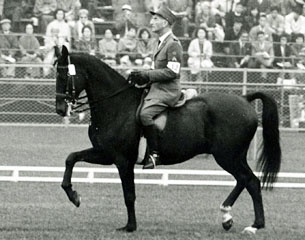
In the early 1960s some dressage competitions were held at Swiss Olympic show jumping rider Paul Weier’s property in Elgg. There a dark bay horse tried to set an infamous record of being more on two than four legs during a test.
Fortunately, the judges did not eliminate the pair, nor did the rider retire. All knew too well that they were doing the resistant horse a favour. At the end the same horse gave in and finished the test with quite some brilliance. This little anecdote illustrates the thin borderline between complete lunacy and the absolute genius of the Swedish bred dressage horse Woermann who was trained and competed by Swiss Olympian Henri Chammartin his entire life.
Woermann came to Switzerland, along with other selected Swedish warmbloods, in the autumn of 1954. At that time the Swiss military imported horses from Sweden for their dressage stable at EMPFA (Swiss military horse depot) in Berne because these horses were often clearly influenced by thoroughbred or Trakehner blood.
Woermann, foaled in 1951, was no exception. His sire Dianthus had the famous foundation Trakehner stallion Humanist as grand sire. Though only 160 cm high, he was a beautiful and well built horse with a little white spot on his nose and a small star on his forehead. Like all horses in the Swiss cavalry coming from Sweden he got a name beginning with “W” and was assigned to one rider responsible for his future training on the day of his arrival from Sweden.
Henri Chammartin, who had already represented Switzerland at the 1952 Olympic Games and had placed 2nd at the unofficial World Championships shortly before at Aachen, received the handsome gelding for training. Chammartin had joined the Swiss cavalry as a 20-year-old in 1938 and became a member and one of the top riders of the dressage stable at EMPFA Berne. He was a rider with a lot of feeling and patience for difficult horses, but on that September day in 1954 he had no idea how his new horse would test his best attributes to the utmost.
Woermann as a Rambunctious Youngster
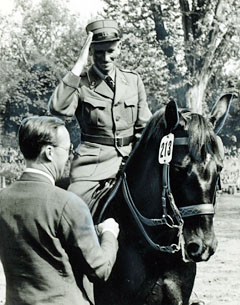 Woermann underwent the usual training programme of a young cavalry horse at the EMPFA. Of course the aim for the dressage horses was to represent the country one day, but the military purposes had to be considered as well. So Woermann had to get used to the traffic of the town, he jumped smaller fences and had to learn all proper manners expected of a horse in the military.
Woermann underwent the usual training programme of a young cavalry horse at the EMPFA. Of course the aim for the dressage horses was to represent the country one day, but the military purposes had to be considered as well. So Woermann had to get used to the traffic of the town, he jumped smaller fences and had to learn all proper manners expected of a horse in the military.
His talent and possibilities as a dressage prospect were obvious, but his difficult and strong willed character were a stumbling block. Whatever he had to learn was no real problem for Woermann, as long as he was in the mood to obey his rider’s aids. “The most difficult thing for my father had been Woermann’s extreme temperament. He wasn’t ill-natured at all, only very cheeky. You just couldn’t be angry with him,” Henri's daughter Marianne Chammartin reminisced.
Woermann could seriously buck and wouldn’t stop after some attempts. “Sometimes his bucking was really dangerous'” said Chammartin’s team mate Marianne Fankhauser (née Gossweiler). Chammartin was the ideal rider for such a horse. He handled the repeated frolicking about with tact, but always tried to be the winner in the end without becoming abusive.
In 1958 the FEI Championships were held in Wiesbaden. Chammartin took his two-time Olympian Wöhler, another Swedish warmblood, for the Grand Prix tour and Woermann and Wolfdietrich for the small tour. He experienced a very successful show by winning all classes and the victory in the Intermediaire I went to his “little devil". Not a bad start for Woermann winning his first international S-competition.
The Move to Grand Prix and The Cure by Canter
 During the next years Woermann became a Grand Prix horse who could do all the exercises brilliantly and easily, especially the passage. Only the piaffe often remained more of a dribbling than one with expressive elevated steps. Chammartin’s second Swede, the identically aged chestnut Wolfdietrich, had the same quality, but was much more reliable and often both horses would compete against each other at a show.
During the next years Woermann became a Grand Prix horse who could do all the exercises brilliantly and easily, especially the passage. Only the piaffe often remained more of a dribbling than one with expressive elevated steps. Chammartin’s second Swede, the identically aged chestnut Wolfdietrich, had the same quality, but was much more reliable and often both horses would compete against each other at a show.
However, the chestnut was not always able to beat the dark devil from next door. At the FEI Championships in 1962 Woermann beat him by finishing second. A year later at the 1963 European Championships Woermann won the Grand Prix, leaving Wolfdietrich behind. But good mood and absolute concentration rarely lasted a weekend long and Wolfdietrich overtook the little rascal in the end and became the individual European Champion while Woermann was left with bronze.
Chammartin never again got the luxurious position to place two horses in the medals as the FEI decided that a rider only allowd to ride one horse at future championships.
 Though Woermann had proven himself as an internationally successful dressage horse he wouldn’t stop switching from genius to devil. Chammartin could never completely rely on him, but one day by coincidence he found a way of curing his naughty nature efficiently.
Though Woermann had proven himself as an internationally successful dressage horse he wouldn’t stop switching from genius to devil. Chammartin could never completely rely on him, but one day by coincidence he found a way of curing his naughty nature efficiently.
“In the midst of a dressage test a beer crate crashed down some metres away from the arena. Woermann went berserk and started bucking like mad. You could forget about an acceptable result and my father was so upset after the ride that he took Woermann to a nearby field and cantered the horse around until he calmed down. After a break Woermann had to compete in another class and won it, completely changed. From then on until the end of the horse’s career my father used the fresh gallop as a formula to calm the horse down before every competition.”
Thrilling 1964 Olympic Games in Tokyo
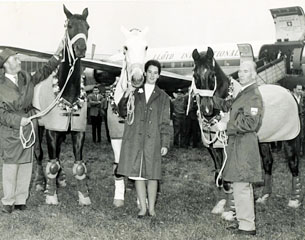 Because of his unpredictability Woermann was always second choice for team selection to his stable mate Wolfdietrich. Anyway Chammartin was in the fortunate position of having two potential horses for the 1964 Olympic Games in Tokyo. But the Olympic year started off badly with both horses catching the equine flu and been sidelined for a while. This interrupted the preparations for the Swiss Olympic trials, but just in time both horses recovered. This time Wolfdietrich left no doubt that he was number 1 by winning all trials.
Because of his unpredictability Woermann was always second choice for team selection to his stable mate Wolfdietrich. Anyway Chammartin was in the fortunate position of having two potential horses for the 1964 Olympic Games in Tokyo. But the Olympic year started off badly with both horses catching the equine flu and been sidelined for a while. This interrupted the preparations for the Swiss Olympic trials, but just in time both horses recovered. This time Wolfdietrich left no doubt that he was number 1 by winning all trials.
When he got ill again just after the trials - this time with jaundice - Chammartin still couldn’t decide whether Woermann would be his no.1 or not. The risk of failure on the Olympic stage and being a member of a team with no drop score seemed incredibly high those days. Because Switzerland wanted to make sure a team would compete in Japan at all costs, the federation nominated Woermann as the team’s reserve horse. One can imagine that nobody hoped to have to make use of that difficult horse!
So Woermann flew to Tokyo with the other three team horses to breathe some Japanese air and enjoy training at the excellent facilities of the Olympic Equestrian Centre. The long and tiring flight in narrow boxes with several stops to refuel didn’t affect him too much, but his companion Wolfdietrich wasn’t too well. The situation deteriorated and it was nerve-wracking for Chammartin. Of course he wanted to ride Wolfdietrich and not risk Woermann’s escapades, but the chestnut just wasn’t fit and in this state it was also hazardous for a team result.
When Wolfdietrich didn’t improve in time and the Swiss chef d’équipe finally decided Chammartin would ride Woermann instead Henri was even a bit relieved. “They had waited with the decision until two hours before the deadline of the subscription. My father believed he had a chance with his reserve horse as long as Woermann would listen to him.”
 The tension and pressure not to let the team down or disappoint his country must have been enormous, as well as the disappointment of not being able to ride his favoured Wolfdietrich. “Henri was depressed that he had to fall back on the reserve horse a day before the Grand Prix. Woermann seemed to be worse, because even on a good day he had the less brilliant piaffe compared to Wolfdietrich’s,” Fankhauser recalled the day in October 1964.
The tension and pressure not to let the team down or disappoint his country must have been enormous, as well as the disappointment of not being able to ride his favoured Wolfdietrich. “Henri was depressed that he had to fall back on the reserve horse a day before the Grand Prix. Woermann seemed to be worse, because even on a good day he had the less brilliant piaffe compared to Wolfdietrich’s,” Fankhauser recalled the day in October 1964.
The worst fears seemed to come true when Chammartin rode Woermann the following day to warm him up before the team competition. The horse reared and bucked and showed not the slightest sense for the big responsibility he carried on his back. Switzerland was a clear medal candidate, but had no drop score in hand in those days because a team included only three riders. One disastrous ride and all medal chances were gone.
“Henri was pale of anger and pressed his lips together. He asked himself why on earth he had taken this devil of a horse as a reserve? He claimed one could see that this had been wasted money”, Fankhauser said about that dreadful moments. When Woermann didn’t calm down and continued his bad behaviour Chammartin did not hesitate any longer. He left the warm up arena and headed straight for the huge racetrack which spanned the whole facility.
“Dressage and jumping riders alike now witnessed a spectacle rarely to be seen on such important occasions. Henri sped his horse around the racetrack which had been approximately 1,5 km long. Woermann galloped it one and a half round before Henri took him to extended trot which he showed half a round. This was followed by 50 metres of energetic passage and finished with 1 metre of piaffe. Then Henri gave Woermann a short break to regain his breath and returned to the warm- up arena,” his team mate Marianne Fankhauser recalled.
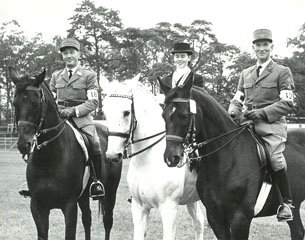 Chammartin did not do much after the gelding’s racetrack episode before he went into the Olympic Grand Prix ring. He rode a Woermann better than ever before. All the impulsion from the racetrack he now showed in a cultivated way. Woermann presented a performance full of highlights, especially the passage, the half passes and extensions were outstanding. The flying changes were faultless. “Such a Woermann we hadn’t seen before. He piaffed as he wanted to save his life,” Fankhauser told Eurodressage.
Chammartin did not do much after the gelding’s racetrack episode before he went into the Olympic Grand Prix ring. He rode a Woermann better than ever before. All the impulsion from the racetrack he now showed in a cultivated way. Woermann presented a performance full of highlights, especially the passage, the half passes and extensions were outstanding. The flying changes were faultless. “Such a Woermann we hadn’t seen before. He piaffed as he wanted to save his life,” Fankhauser told Eurodressage.
In the end he placed 2nd behind Harry Boldt’s small Ramzes AA-son Remus. The Swiss team finished with the silver medal, only 32 points behind Germany. But for Woermann the battle wasn’t yet over. The set-up for an individual medal was surprisingly good. Chammartin wondered whether it would be possible to achieve an individual medal without Wolfdietrich? Chammartin had 19 points less than Remus in the Grand Prix, but as the Special was added to this result everything was possible.
Woermann seemed to have had enough racing around the track and didn’t need such extra work on the day of the individual final. He still expressed a fitness which not all horses were able to show. “Ih hindsight it had been an advantage that my father had prepared Wolfdietrich much more thoroughly than Woermann. This kept him fresher and more energetic than all the other horses.”
The little Swede started the ride with an obedient immobile halt, but then broke into canter in the first trot extension. Was it the start of Woermann slipping back into his naughty behaviour? Chammartin must have felt that his horse wouldn’t because he immediately risked everything in the following extension after he had put Woermann back to trot. He continued presenting the horse with lots of impulsion and energy. With such a sensible and noise-sensitive horse it was riding at the edge, but Chammartin had no choice but to risk it.
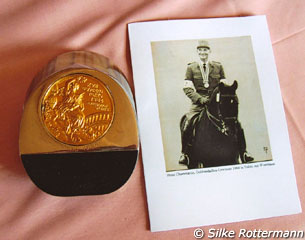 He succeeded and finished again in 2nd place behind the winner of the Spécial, the Russian Sergej Filatov on the most beautiful Akhal Teke Absent. The Grand Prix winner Remus only placed 4th this time. In the end, after adding the Special points to the ones of the Grand Prix, a neck-to-neck result was the outcome. Woermann had won the individual gold medal just one point ahead of the unlucky Harry Boldt on Remus.
He succeeded and finished again in 2nd place behind the winner of the Spécial, the Russian Sergej Filatov on the most beautiful Akhal Teke Absent. The Grand Prix winner Remus only placed 4th this time. In the end, after adding the Special points to the ones of the Grand Prix, a neck-to-neck result was the outcome. Woermann had won the individual gold medal just one point ahead of the unlucky Harry Boldt on Remus.
It was a unique story! Woermann, this cheeky devil, who had caused trouble so often, won the Olympic gold medal,”Fankhauser commented.
It may not happen again that a reserve horse wins gold in Olympic dressage. Woermann proved wrong everyone who thought that due to his exuberant temperament he would always remain in Wolfdietrich’s shadow. For Henri Chammartin the individual Olympic title was the highlight of his career. It meant even more: winning it aboard such an extremely difficult horse. This was probably more satisfying after all the work he had invested in Woermann.
Swiss Heroes
 After their glorious return from Tokyo the names of Chammartin and Woermann were known all over Switzerland. Henri was aware that continuing Woermann’s career after such an unexpected gold medal could only bring a downfall in results, so it was decided to retire the golden rascal at his peak.
After their glorious return from Tokyo the names of Chammartin and Woermann were known all over Switzerland. Henri was aware that continuing Woermann’s career after such an unexpected gold medal could only bring a downfall in results, so it was decided to retire the golden rascal at his peak.
Like all of Chammartin’s retired dressage horses Woermann served as a valuable schoolmaster for Chammartin’s pupils in the cavalry until the end of the 1960s. In 1971 Woermann could no longer be ridden and age was troubling him increasingly. “Wolfdietrich and Woermann had both been troubled by signs of old age and it was decided to euthanize them. They were put down on the same day in 1971,” said Marianne Chammartin. Two horses that joined Henri Chammartin on the same day in 1954 left him together 17 years later.
Woermann, that cheeky little horse from Sweden, had in some ways been Henri Chammartin’s masterpiece. In the most crucial moments of his rider’s career Woermann stood by him as a living reward for Henri''s patience and feeling for him over the years.
Article by Silke Rottermann (as told by Marianne and Henri Chammartin, Marianne Fankhauser and Hansruedi Thomi)
Related Links
Wolfdietrich, Chammartin's Aristocrat
Absent, an Akhal Teke on the Olympic Stage